Dr.Teruo Higa’s
Living A Dream
- 2025
- Sep:#209 The Widespread Use of EM in Ecuador
- Sep:#208 The Widespread Use of EM in Chile
- Jul:#207 Peru, where EM has taken root throughout the country
- May:#206 EM Application Technology in Paraguay Begins to Evolve into Advanced Circular Agriculture
- May:#205 Practical Application of Soil Disinfectant-Free Cultivation Using EM Technology
- Apr:#204 How EM Use Has Spread Throughout the Philippines
- Mar:#203 How to Use EM to Fundamentally Solve the Problem of Agricultural Residue Burning
- Feb:#202 The Spread of EM technology in Germany
- Jan:#201 The 2nd Ichiro Masaki Memorial Universal Village EM International Conference
- Jan:#200 Cleanup of the Ala Wai Canal in Hawaii, where social bonds are strengthened using EM
- 2024
- Nov:#199 EM trials in India with bananas, tomatoes, and pomegranates
- Oct:#198 The Steadily Evolving EM Nature Farming Method at the Blue Sky Palace - Part 8
- Sep:#197 The Steadily Evolving EM Nature Farming Method at the Blue Sky Palace - Part 7
- Aug:#196 The Steadily Evolving EM Nature Farming Method at the Blue Sky Palace - Part 6
- Jul:#195 The Steadily Evolving EM Nature Farming Method at the Blue Sky Palace - Part 5
- Jun:#194 Steadily Evolving EM Nature Farming Method at the Blue Sky Palace - Part 4
- May:#193 Steadily Evolving EM Nature Farming Method at the Blue Sky Palace - Part 3
- May:#192 Steadily Evolving EM Nature Farming Method at the Blue Sky Palace - Part 2
- Apr:#191 Steadily Evolving EM Nature Farming Method at the Blue Sky Palace
- Mar:#190 Quantum Mechanical Effects of EM Gravitron Charcoal
- Mar:#189 The barrier space in Okinawa (Ryukyu Islands) has risen to another dimension
- Jan:#188 Sixty Days after Typhoon No.6
- 2023
- Oct:#187 Supermassive Typhoon No.6 and Subsequent Typhoon No. 11
- Sep:#186 Massive Typhoon No.6 that swallowed the Ryukyu Islands Graviton barrier
- Sep:#185 August 8th is World “EM Mudball Day”
- Aug:#184 A disease-free life depends on the health of the intestinal microbiome.
- Jul:#183 Trial and Error at the Blue-Sky Palace, Part 3
- Jun:#182 Trial and Error at the Blue-Sky Palace, Part 2
- Apr:#181 Trial and Error at the Blue-Sky Palace
- Mar:#180 Ala Wai Canal Cleanup Project in Waikiki, Hawaii
- Feb:#179 High-Yield, High-Quality Rice Production Using EM
- Feb:#178 The Progress the "Soil Preparation Workshop" of the Oishi 3-chan Club (Part 2)
- Jan:#177 Organic Farming Instructional Manual Using EM
- 2022
- Nov:#176 The Typhoon Situation in Okinawa in 2022
- Sep:#175 Third-Party Verification of the Graviton barrier in Okinawa Part-2
- Sep:#174 Third-Party Verification of the Graviton barrier in Okinawa
- Aug:#173 Ecosystem Changes Observed in Okinawa in 2021 Part-5
- Jun:#172 Ecosystem Changes Observed in Okinawa in 2021 Part-4
- May:#171 Ecosystem Changes Observed in Okinawa in 2021 Part-3
- Apr:#170 Ecosystem Changes Observed in Okinawa in 2021 Part-2
- Mar:#169 Koizumi Farm in Kamakura Continues to Evolve
- Feb:#168 Ecosystem Changes Observed in Okinawa in 2021 Part-1
- 2021
- Dec:#167 Enjoying EM Technology While Enriching the Local Ecosystem
- Nov:#166 A Case Study of the Use of EM in a Next Generation Free School in Tune with the Cycles of Nature
- Oct:#165 Typhoon conditions and flowers in Okinawa from August to October
- Sep:#164 Re-learning the origins of river purification using EM Cleaning up the Dairyuji River in Senami (Murakami City, Niigata Prefecture)
- Aug:#163 Measures Against Natural Disasters and Re-learning the Starting Point of EM
- Jul:#162 Summary of FFC (Foods for Children) Okinawa Forum 2021
- Jun:#161 Restoring the Vigor of an Old Tree and Purifying the Environment with EM Technology That Even an Amateur Can Do
- May:#160 The Public is Beginning to Recognize the Use of EM Smokeless Carbonizers
- Apr:#159 EM Hado (EM Graviton) that exerts quantum superposition effect over time
- Mar:#158 Virus-free Okinawan Plants Through Use of an EM Graviton Barrier
- Jan:#157 Enjoyable Farming for Self-Sufficiency that Even Amateurs Can Do
- 2020
- Dec:#156 EM quantum energy effect occurring in Okinawa
- Nov:#155 Implementing EM graviton farming as a flood countermeasure for apple orchards
- Oct:#154 The Latest Book on the Practical Uses of EM "You Are the One Who Draws Out the Power of Microorganisms," by Chizuko Nomoto
- Sep:#153 Application of EM technology to long periods of rain, lack of sunshine, storms, heavy rains, etc.
- Aug:#152 EM application in Kitanakagusuku village plant waste recycling yard
- Jul:#151 Natural Disaster Countermeasures Using EM Technology: Part 2
- Jul:#150 Natural Disaster Countermeasures Using EM Technology
- May:#149 How to make your home and workplace an energy spot by living a complete EM lifestyle: creating the ultimate source of health and environmental purification
- Apr:#148 EM, Viruses and the Pandemic
- Apr:#147 New agriculture applying quantum mechanics Part 2
- Apr:#146 New agriculture applying quantum mechanics
- Apr:#145 Wonderful EM Miracle
- 2019
- Nov:#144 The movie “Revival II” and the reality of Fukushima
- Oct:#143 Boundary dome and foliar spraying of EM・X GOLD and EM 3
- Oct:#142 Kirakira (Sparkling) Summer Vegetable Festa in 2019
- Aug:#141 Excessive salt inevitably causes salt damage
- Jul:#140 Diverse applications of charcoal Part 3
- Jun:#139 Diverse applications of charcoal Part 2
- Jun:#138 Diverse applications of charcoal
- Jun:#137 Purification power of salt
- May:#136 The degree of soil contamination is a reflection of the microflora
- May:#135 Definitive use of EM barriers to deal with typhoons
- May:#134 Implementing authentic Nature Farming
- May:#133 How to enhance healthy Hado (wave energy) by EM
- May:#132 Eating Dirt (Soil)
- May:#131 Hado (Wave energy) involved in health
- May:#130 Reaffirming EM technology to realize the essence of agriculture
- May:#129 The 2nd EM Producer Networking Meeting
- Apr:#128 Understanding the application of seawater and salt in crop cultivation
- Apr:#127 Prevention of Disasters by EM Technology
- Mar:#126 Quantum overlay effective utilization of EM
- Jan:#125 EM Disaster Recovery Support Projects in 2017
- 2018
- 2017
- Aug:#121 Escape from conventional agricultural traps
- Jul:#120 Limitation and important caveats regarding utilization of salt
- Jun:#119 EM Technology to Break Through the Limits of Pesticide-Free Strawberries
- May:#118 Application of barriers using EM rectification force
- Apr:#117 The 1st EM Produce Growers' Networking Conference
- Mar:#116 Sumizo kun: The Ultimate Versatile Carbonization Equipment
- Feb:#115 How to make and use simple carbonized and rectified ash
- Jan:#114 Achievements of 2016
- 2016
- Dec:#113 Definitive Measures Against Typhoons
- Nov:#112 International Conference on Universal Village
- Oct:#111 90% of Your Body is Microbes
- Sep:#110 Disaster Countermeasures Using EM
- Aug:#109: Changes in the Natural Environment by EM Barrier Domes in Okinawa
- Jul:#108: Multi-purpose Utilization of Activated EM with Seawater and Salt
- Jun:#107: Marine Day, when EM Mudballs and Activated EM are Applied Throughout Japan
- May:#106: The Function of EM and Gravitational Waves–Part 3
- Apr:#105: The Function of EM and Gravitational Waves–Part 2
- Feb:#104: The Function of EM and Gravitational Waves
- Feb:#103: The Importance of Phototrophic Bacteria in EM
- 2015
- Dec:#102: Results of Environmental Forum "Utsukushima EM Paradise" 2015
- Nov:#101: Environmental Forum "Utsukushima EM Paradise" 2015
- Oct:#100: A New Phase of Limit Breakthrough Using EM
- Sep:#99: A New Phase of Limit Breakthrough through EM
- Aug:#98: The Tokyo Bay Area Began Creating a Truly Livable Hometown
- Jul:#97: Rectifying Effects of EM
- Jun:#96: Lake Suwa Sousei lecture
- May:#95: In Order to Further Ensure Limit Breakthrough
- Apr:#94: Theatrical Release of the Documentary Film SOSEI-Revival to Enlighten People on the New Possibilities of Microorganisms
- Mar:#93: What Underlies Limit Breakthrough (Part 2)
- Feb:#92: EM Functions to Break Through Limits
- Jan:#91: At the Start of 2015
- 2014
- Dec:#90: Looking Back at 2014
- Nov:#89: Shikoku EM FESTA 2014, Virtuous Circle Conference in Matsuyama, Ehime Prefecture
- Oct:#88: Using EM to Deal with Weather Disasters (Part 2)
- Sep:#87: Current Status of Radioactivity Measures Using EM in Fukushima
- Aug:#86: APNAN (Asia Pacific Natural Agriculture Network) 25th Anniversary Conference in 2014
- Jul:#85: Using EM to Deal with Weather Disasters
- Jun:#84: Substantial Improvement of Soil
- May:#83: The Energy Rectification Force of EM
- Apr:#82: The Annual 18th EM Technology Exchange Meeting and Tohoku Conference in Shichigahama
- Mar:#81: Salmon going upstream in Kitaura (Kasumigaura)
- Feb:#80: The Microbiome Again
- Jan:#79: Inauguration of the Federation of Diet Members Who Use and Apply Effective Microorganisms
- 2013
- Dec:#78: Receiving an Honorary Doctoral Degree from Rajamangala University of Technology in Thailand
- Nov:#77: The Use of EM in School Education in Bhutan
- Oct:#76: Well of Bonding
- Sep:#75: The Background to EM Not Being Employed by Public Institutions to Deal with Radiation
- Aug:#74: Dealing with Disaster: Using EM in Crisis Management
- Jul:#73: EM Events on Ocean Day
- Jun:#72: Using EM to Deal With Heat Stroke and Summer Heat Fatigue
- May:#71: An EM Model Town in Malaysia
- Apr:#70: Steps the Japanese Government is Taking to Deal with Radiation: Are They Really Safe?
- Mar:#69: EM Group Disaster Reconstruction Aid Project in Fukushima
- Feb:#68: EM and Microbiomes (Microbial Flora)
- Jan:#67: A Necessary Evil is Still Evil
- 2012
- Dec:#66: The 17th National EM Technology Exchange Conference / Hokkaido Conference in Sapporo
- Nov:#65: EM Forum 2012 in Okinawa and the Environmental Forum in Fukushima
- Oct:#64: 2012 EM Forum
- Sep:#63: A New Earth Saving Revolution
- Aug:#62: The Asahi Newspaper’s Misguided Reports About EM
- Jul:#61: Using EM in Radioactive Contamination Measures in Fukushima Prefecture
- Jun:#60: The Effects of Using EM to Inhibit the Absorption of Radioactivity as Confirmed in Fukushima
- May:#59: Recovery Support for the Great East Japan Earthquake
- Apr:#58: The Royal Kingdom of Thailand, in which EM Functions as a Set Government Policy
- Mar:#57: Report on the Measures Taken by Kingdom of Thailand Using EM to Deal with Polluted Water
- Feb:#56 EM™ as Part of National Policy in Thailand to Deal with Sanitation Issues Resulting from the Flood of 2011
- Jan:#55 The Law of Syntropy (Revitalization)
- 2011
- Dec:#54 EM Forum 2011
- Nov:#53 Shikoku EM Festa 2011- Zenjunkan no Wa (Virtuous Circle) Tokushima Conference in Naruto -
- Oct:#52 The Mystery of Interim Safety Values for Radioactive Material
- Sep:#51 Successful Radiation Countermeasures Using EM
- Aug:#50 Events on Sea Day in which EM Mud Balls are Thrown into the Water and Activated EM is Applied.
- May:#47 Dealing with the Damage Caused by the Eastern Japan Earthquake
- Apr:#46 Eastern Japan Earthquake
- Mar:#45 The 16th National EM Technology Hokuriku Conference in Fukui
- Feb:#44 More Thoughts on Avian Influenza and Foot-and-Mouth Disease
- Jan:#43 Happy New Year!
- 2010
- Dec:#42 Shikoku EM FESTA 2010・Zenjunkan no wa (Virtuous Circle) Fellowship Conference in Tobe, Ehime Prefecture
- Nov:#41 EM Forum 2010
- Oct:#40: My Thanks to the EM™ Volunteers Who Helped in the Fight Against Foot-and-Mouth Disease in Miyazaki Prefecture
- Sep:#39 International EM Mud Ball Day
- Jul:#37 Poland EM Forum 2010
- Jun:#36 EM Countermeasures Against Foot-and-Mouth Disease
- May:#35 Abnormal Weather
- Apr:#34 EM Activities in Thailand: Finding Solutions to the Challenges Facing the Nation
- Mar:#33 New Developments in the Evolution of EMTM in Thailand
- Feb:#32 Results Starting to Be Seen at the Mikasa Project
- Jan:#31 Towards an EM-Use Society
- 2009
- Dec:#30 EM Summit
- Nov:#29 The System in Penang State in Malaysia that Made the World EMTM Mudball Day a Success
- Oct:#28 The "World EM Mudball Day" in Malaysia
- Sep:#27 Validating EMTM Medicine: Case Study Reports from EM Users 2009. (Part 3)
- Sep:#26 Validating EMTM Medicine: Case Study Reports from EMTM Users 2009. (Part 2)
- Jul:#25 Validating EMTM Medicine: Case Study Reports from EMTM Users 2009. (Part 1)
- Jun:#24 Activities to Disseminate EM-Focused Nature Farming in China
- May:#23 Use of EMTM in Response to Swine Flu
- Apr:#22 Using EM to Solve Public Administrative Costs
- Mar:#21 Reaffirming the Versatility of EM
- Jan:#20 The Beginning of a New Era
- 2008
#174 Third-Party Verification of the Graviton barrier in Okinawa
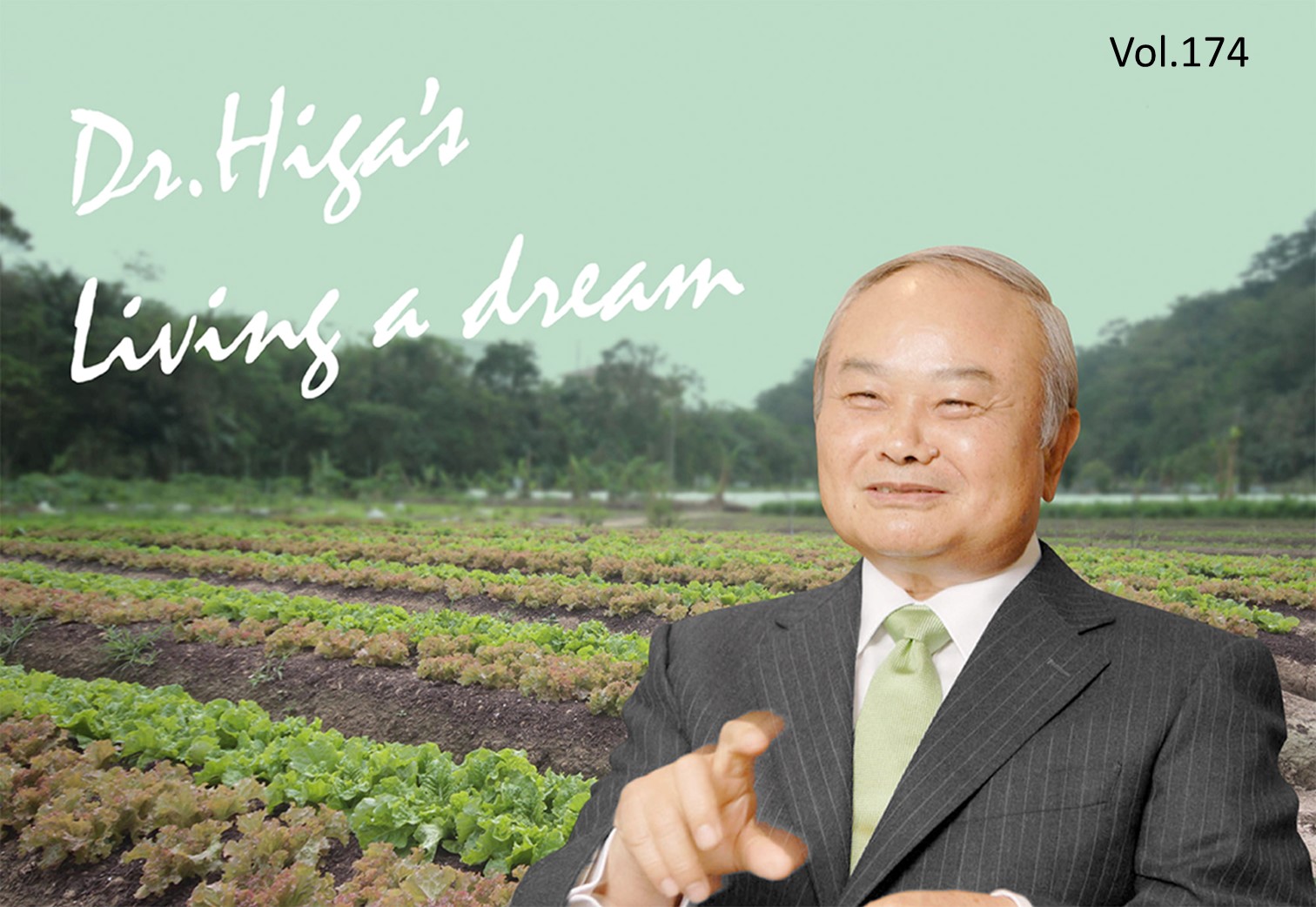
As I have mentioned many times, the graviton barrier that was accidentally created for the Ryukyu Islands in November 2013 has produced promising results in various natural phenomena.
Since a significant portion of the ultraviolet rays in summer has been converted to infrared rays, red sunburns have been significantly reduced, cars and buildings have been cleaned and made shiny by the infrared rays’ effect, and the natural health of the Ryukyu Islands has been improving yearly. We have hardly any extremely hot days anymore, and it’s clear that once you’re in Okinawa you feel more energetic, your work efficiency improves, and there’s a kind of overall healing effect.
Elementary schools, which have always been the worst in the nation in national achievement tests, have suddenly jumped to 23rd in the ranking starting in 2014, and then improved year by year, finally joining the top group. Junior high schools are still last, but I explain the cause below.
In other words, the entire Ryukyu Islands have a rectification function of electromagnetic waves attributable to the graviton barrier, and harmful electromagnetic waves have been reduced. Functional electromagnetic waves enhance the ability to concentrate, an effect that has been seen in elementary schools. However, those children who were in the top group of the list fell to the bottom when they became junior high school students. Daily study is important at the junior high school level, but it is said that junior high school students in Okinawa study the least in Japan, and if improvements can be made in this area, it will be possible for them to be ranked higher.
Other phenomena seen because of the graviton barrier effect are that food items in the refrigerator are less likely to spoil and beverage products in vending machines have become more like health drinks. The O-ring test shows positive results for everything from the Ryukyu Islands, while everything in other places registers as negative. In addition, there is less damage from typhoons year by year, and typhoons are more likely to occur in the waters around Okinawa. The typhoons that occur in the neighboring seas pass by before the atmospheric pressure becomes too low, so they do not cause strong wind or flood damage, and the rain is more a blessing.
The mysterious phenomenon of increased work efficiency has been attracting attention among IT companies for the past five to six years, and there have been more cases of companies moving their headquarters to Okinawa, which has even been featured on NHK, (the Japan Broadcasting Corporation). The scientific basis that everyone loves so much has been ignored in favor of repeating unscientific explanations that people can more easily understand.
But surprise! Now there is scientific evidence that this is true. The results were done completely independent of us. I recommend you read the following article several times.
Since a significant portion of the ultraviolet rays in summer has been converted to infrared rays, red sunburns have been significantly reduced, cars and buildings have been cleaned and made shiny by the infrared rays’ effect, and the natural health of the Ryukyu Islands has been improving yearly. We have hardly any extremely hot days anymore, and it’s clear that once you’re in Okinawa you feel more energetic, your work efficiency improves, and there’s a kind of overall healing effect.
Elementary schools, which have always been the worst in the nation in national achievement tests, have suddenly jumped to 23rd in the ranking starting in 2014, and then improved year by year, finally joining the top group. Junior high schools are still last, but I explain the cause below.
In other words, the entire Ryukyu Islands have a rectification function of electromagnetic waves attributable to the graviton barrier, and harmful electromagnetic waves have been reduced. Functional electromagnetic waves enhance the ability to concentrate, an effect that has been seen in elementary schools. However, those children who were in the top group of the list fell to the bottom when they became junior high school students. Daily study is important at the junior high school level, but it is said that junior high school students in Okinawa study the least in Japan, and if improvements can be made in this area, it will be possible for them to be ranked higher.
Other phenomena seen because of the graviton barrier effect are that food items in the refrigerator are less likely to spoil and beverage products in vending machines have become more like health drinks. The O-ring test shows positive results for everything from the Ryukyu Islands, while everything in other places registers as negative. In addition, there is less damage from typhoons year by year, and typhoons are more likely to occur in the waters around Okinawa. The typhoons that occur in the neighboring seas pass by before the atmospheric pressure becomes too low, so they do not cause strong wind or flood damage, and the rain is more a blessing.
The mysterious phenomenon of increased work efficiency has been attracting attention among IT companies for the past five to six years, and there have been more cases of companies moving their headquarters to Okinawa, which has even been featured on NHK, (the Japan Broadcasting Corporation). The scientific basis that everyone loves so much has been ignored in favor of repeating unscientific explanations that people can more easily understand.
But surprise! Now there is scientific evidence that this is true. The results were done completely independent of us. I recommend you read the following article several times.
Working in Okinawa improves sleep and concentration!
Workcation verification by the prefecture
(Partial quote) An experiment conducted on the same people in Tokyo and Okinawa showed that working in Okinawa improved “sleep quality,” “concentration,” and “inspiration,” as well as reduced “stress.”
Ryukyu Shimpo March 18th, 2022
(Go to the article citation for the full text)
Workcation verification by the prefecture
(Partial quote) An experiment conducted on the same people in Tokyo and Okinawa showed that working in Okinawa improved “sleep quality,” “concentration,” and “inspiration,” as well as reduced “stress.”
Ryukyu Shimpo March 18th, 2022
(Go to the article citation for the full text)
------------------------------
Ryukyu Shimpo, March 18, 2022
Working in Okinawa boosts “sleep” and “concentration”!
Prefectural Government Verifies “Workcation”
The Okinawa Prefectural Department of Culture, Tourism and Sports Department has recently verified the physical and mental health benefits of “workcations,” in which people telework while enjoying their vacations. The results of an experiment conducted on the same person in Tokyo and Okinawa showed that working in Okinawa improved “sleep quality,” “concentration,” and “inspiration,” and also led to a reduction in “stress.” By job category, “marketing professionals” were found to most likely benefit.
The survey was conducted on five men and women in their 30s and 40s working in marketing, administration, research, engineering, and sales. The five people were divided into two teams and stayed in Yaeyama (Ishigaki and Taketomi Islands) and Naha, Chubu areas for 3 nights and 4 days from November 8 to 11, 2021. They had experiences that made the most of the characteristics of each region and were able to corroborate the effectiveness of the project.

Participants in the demonstration experiment of the “Okinawa Workcation Promotion Project” doing yoga along the prefecture’s coastline in November 2021 (photo provided).
------------------------------
Ryukyu Shimpo, March 18, 2022
Working in Okinawa boosts “sleep” and “concentration”!
Prefectural Government Verifies “Workcation”
The Okinawa Prefectural Department of Culture, Tourism and Sports Department has recently verified the physical and mental health benefits of “workcations,” in which people telework while enjoying their vacations. The results of an experiment conducted on the same person in Tokyo and Okinawa showed that working in Okinawa improved “sleep quality,” “concentration,” and “inspiration,” and also led to a reduction in “stress.” By job category, “marketing professionals” were found to most likely benefit.
The survey was conducted on five men and women in their 30s and 40s working in marketing, administration, research, engineering, and sales. The five people were divided into two teams and stayed in Yaeyama (Ishigaki and Taketomi Islands) and Naha, Chubu areas for 3 nights and 4 days from November 8 to 11, 2021. They had experiences that made the most of the characteristics of each region and were able to corroborate the effectiveness of the project.

Participants in the demonstration experiment of the “Okinawa Workcation Promotion Project” doing yoga along the prefecture’s coastline in November 2021 (photo provided).
------------------------------
This difference is quite staggering and has a cumulative effect, so it has become a fundamental force for the promotion of tourism and relocation to local areas, which has been a boom in the Ryukyu Islands centered on Okinawa and has revitalized the islands.
What should be noted, too, is the recent activity in Amami Oshima Island, which is part of the Ryukyu Islands. The people of Kagoshima Prefecture, to which Amami belongs, have been amazed by this phenomenon. (The islands are beginning to revitalize themselves, including two recent appearances at the prestigious national high school baseball championship, which is held at Koshien Stadium in Hyogo Prefecture.)
Reports on flower and bird activities occurring in Okinawa
In the past, I used to envy Hawaii when its flowers were in full bloom, comparing it to the miserable condition of the Golden Showers in Okinawa, where typhoons made it difficult for the flowers to fully bloom. Now, however, they bloom as well as they do in Hawaii. (Articles 1 and 2)
The Sagaribana, barringtonia racemose, which is resistant to salt damage and typhoons, has spread throughout the region and has become a symbolic flower of Okinawa. (Articles 3 and 4)
Flowers have become more voluminous and open more fully, and Tokkuriran, Ponytail palm, which was rare until now, can be found blooming in various locations. (Articles 5 and 6).
The cumulative effect of the graviton barrier has resulted in fruit trees in gardens that rarely bore fruit now bearing abundant fruit. (Articles 7-9)
I will also add information about birds (Articles 10 and 11).
------------------------------
What should be noted, too, is the recent activity in Amami Oshima Island, which is part of the Ryukyu Islands. The people of Kagoshima Prefecture, to which Amami belongs, have been amazed by this phenomenon. (The islands are beginning to revitalize themselves, including two recent appearances at the prestigious national high school baseball championship, which is held at Koshien Stadium in Hyogo Prefecture.)
Reports on flower and bird activities occurring in Okinawa
In the past, I used to envy Hawaii when its flowers were in full bloom, comparing it to the miserable condition of the Golden Showers in Okinawa, where typhoons made it difficult for the flowers to fully bloom. Now, however, they bloom as well as they do in Hawaii. (Articles 1 and 2)
The Sagaribana, barringtonia racemose, which is resistant to salt damage and typhoons, has spread throughout the region and has become a symbolic flower of Okinawa. (Articles 3 and 4)
Flowers have become more voluminous and open more fully, and Tokkuriran, Ponytail palm, which was rare until now, can be found blooming in various locations. (Articles 5 and 6).
The cumulative effect of the graviton barrier has resulted in fruit trees in gardens that rarely bore fruit now bearing abundant fruit. (Articles 7-9)
I will also add information about birds (Articles 10 and 11).
------------------------------
Okinawa Times, Saturday, June 25, 2022
Golden Flowers Pouring Down
Highest temperature of the year at 14 locations in the prefecture
On June 24th, it was hot days in midsummer in the Okinawa region, with Hateruma Island recording 33.7 ℃, and in various places. The highest temperature of the year was recorded at 14 observation sites, including 33.1℃ in Ohara Taketomi Town and 31.4℃ in Ashimine, Naha City.
On a city road in Higashimachi, Naha City, bright yellow flowers in the summer sunlight were blooming on a golden shower tree (namban saikachi). The shower-like beads of flowers are a delight to the eyes of passersby. According to the Okinawa Meteorological Observatory, the Okinawa region will be covered by high pressure on the 25th, and the weather will be generally sunny. (Photo by Daiki Nago)
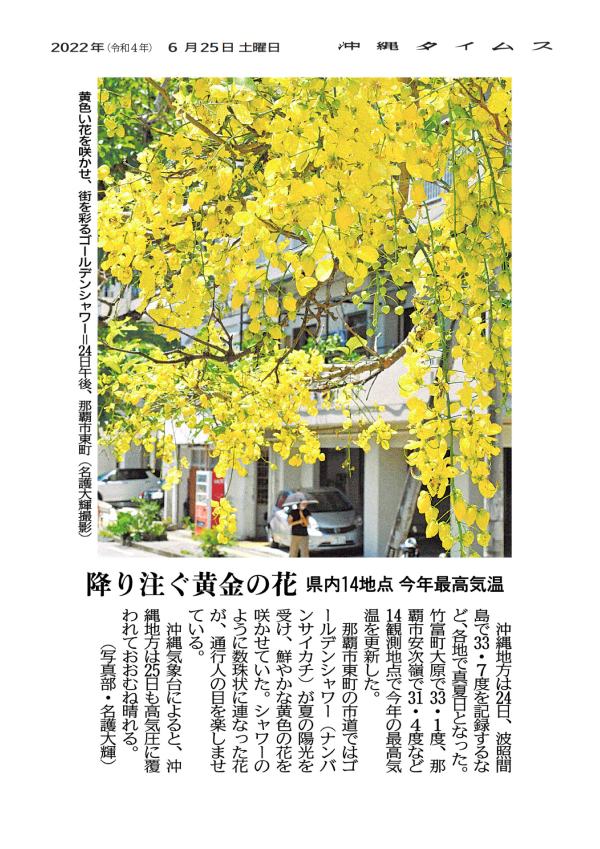
Golden shower with its yellow blossoms, brightening the streets of Okinawa Higashimachi, Naha City, on the afternoon of August 24th. (Photo by Daiki Nago)
------------------------------
Golden Flowers Pouring Down
Highest temperature of the year at 14 locations in the prefecture
On June 24th, it was hot days in midsummer in the Okinawa region, with Hateruma Island recording 33.7 ℃, and in various places. The highest temperature of the year was recorded at 14 observation sites, including 33.1℃ in Ohara Taketomi Town and 31.4℃ in Ashimine, Naha City.
On a city road in Higashimachi, Naha City, bright yellow flowers in the summer sunlight were blooming on a golden shower tree (namban saikachi). The shower-like beads of flowers are a delight to the eyes of passersby. According to the Okinawa Meteorological Observatory, the Okinawa region will be covered by high pressure on the 25th, and the weather will be generally sunny. (Photo by Daiki Nago)

Golden shower with its yellow blossoms, brightening the streets of Okinawa Higashimachi, Naha City, on the afternoon of August 24th. (Photo by Daiki Nago)
------------------------------
Okinawa Times, Friday, July 8, 2022
Golden color in the blue sky of Motobu Town
Golden Shower tree (Fabaceae) is blooming at Mr. Koba’s house
The bright yellow flowers of the Nanbansaikachi (Fabaceae) at the home of Hideo Koba, 74, in Katsuu, Motobu Town, are now seventy percent in full bloom, delighting the eyes of visitors. The appearance of them hanging from tree branches led to another name for them: “Golden Shower.” They are native to India and are the national flower of Thailand. A cousin of Mr. Koba’s father planted the seeds about forty years ago when he brought them from Brazil.
“When I first saw it, I thought it was a wisteria flower. The Golden color flowers suit Okinawa well,” said Natsuko Nakasone, 82, and Katsumi Oshiro, 72, friends of Koba’s wife, Sachiko 77, who came from Nago City to observe the flowers.
Mr. Koba happily explained that, “The orange jessamine I planted near the base of the golden shower tree had grown, so I cut it down, and another trunk grew from the base of the golden shower tree, expanding the width of its branches. In the mornings and evenings, bees are busy buzzing around the flowers.”
The yellow blossoms of the golden shower looked beautiful against the blue sky.
(Reported by Manabu Tamaki)
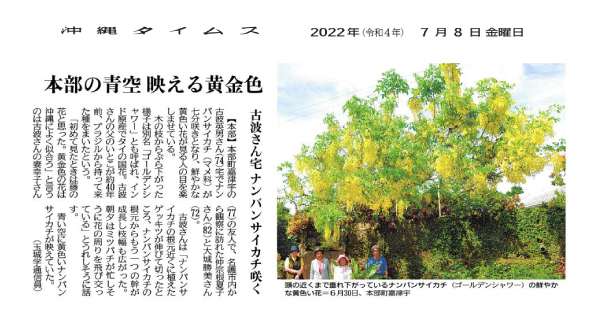
Brilliant yellow flowers of the golden shower tree hanging down close to one’s head, June 30, Katsuu, Motobu Town.
------------------------------
Golden color in the blue sky of Motobu Town
Golden Shower tree (Fabaceae) is blooming at Mr. Koba’s house
The bright yellow flowers of the Nanbansaikachi (Fabaceae) at the home of Hideo Koba, 74, in Katsuu, Motobu Town, are now seventy percent in full bloom, delighting the eyes of visitors. The appearance of them hanging from tree branches led to another name for them: “Golden Shower.” They are native to India and are the national flower of Thailand. A cousin of Mr. Koba’s father planted the seeds about forty years ago when he brought them from Brazil.
“When I first saw it, I thought it was a wisteria flower. The Golden color flowers suit Okinawa well,” said Natsuko Nakasone, 82, and Katsumi Oshiro, 72, friends of Koba’s wife, Sachiko 77, who came from Nago City to observe the flowers.
Mr. Koba happily explained that, “The orange jessamine I planted near the base of the golden shower tree had grown, so I cut it down, and another trunk grew from the base of the golden shower tree, expanding the width of its branches. In the mornings and evenings, bees are busy buzzing around the flowers.”
The yellow blossoms of the golden shower looked beautiful against the blue sky.
(Reported by Manabu Tamaki)

Brilliant yellow flowers of the golden shower tree hanging down close to one’s head, June 30, Katsuu, Motobu Town.
------------------------------
Okinawa Times, Saturday, July 9, 2022
Sagaribana, Barringtonia recamosa, Shower of racemes
A spectacular view of 5,000
“This is the first time for me to see it”
In Nakao-ku, Nago City
About 5,000 racemes. About 30 Sagaribana, barringtonia racemose (Lecythidacese) planted five years ago are in full bloom now and delighting visitors to the flower beds in front of the community center and park in Nakao-ku (Seiichi Tamaki, ward head), Nago City, Okinawa Prefecture.
This year, too, they began to bloom around the consecutive holidays in May. During the rainy season, the flowers soon fell, but they have been blooming every night since the end of the rainy season. Each four-meter-high tree has about 200 racemes hanging down, ranging from about forty centimeters to one meter in length, and including all the Sagaribana trees there are about 5,000 racemes hanging down, waiting to bloom.
Mr. Tamaki, head of Nakao Ward, admiring the racemes, said, “I have never seen so many racemes hanging down. It’s spectacular. Local residents of the ward are so fortunate to observe them, and I expect they will bloom every night until around October.” On the morning of the 6th, Sagaribana petals fell in the park, creating a pink and white carpet on the grass. (Reported by Manabu Tamaki)
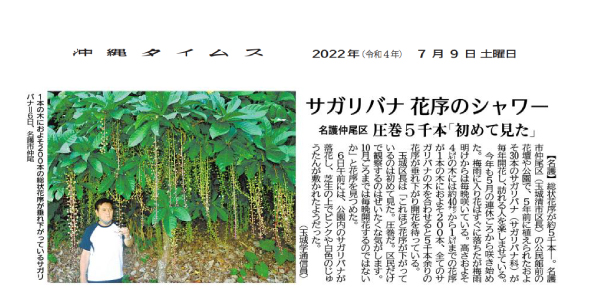
About 200 total racemes hanging from a single tree, July 6th, Nakao-ku, Nago City
Photo: “I wonder if it was in bloom even during the Jomon period. The ‘Phantom overnight blossoms’ remind us of the boundless history.”
------------------------------
Sagaribana, Barringtonia recamosa, Shower of racemes
A spectacular view of 5,000
“This is the first time for me to see it”
In Nakao-ku, Nago City
About 5,000 racemes. About 30 Sagaribana, barringtonia racemose (Lecythidacese) planted five years ago are in full bloom now and delighting visitors to the flower beds in front of the community center and park in Nakao-ku (Seiichi Tamaki, ward head), Nago City, Okinawa Prefecture.
This year, too, they began to bloom around the consecutive holidays in May. During the rainy season, the flowers soon fell, but they have been blooming every night since the end of the rainy season. Each four-meter-high tree has about 200 racemes hanging down, ranging from about forty centimeters to one meter in length, and including all the Sagaribana trees there are about 5,000 racemes hanging down, waiting to bloom.
Mr. Tamaki, head of Nakao Ward, admiring the racemes, said, “I have never seen so many racemes hanging down. It’s spectacular. Local residents of the ward are so fortunate to observe them, and I expect they will bloom every night until around October.” On the morning of the 6th, Sagaribana petals fell in the park, creating a pink and white carpet on the grass. (Reported by Manabu Tamaki)

About 200 total racemes hanging from a single tree, July 6th, Nakao-ku, Nago City
Photo: “I wonder if it was in bloom even during the Jomon period. The ‘Phantom overnight blossoms’ remind us of the boundless history.”
------------------------------
Okinawa Times, Saturday, July 2, 2022
Thinking of the Jomon Period
Sagaribana, barringtonia racemose decorate the ruins in Chatan
On January 1st, the first “Jomon Night” was held at the Ireibaru Ruins in Chatan Town, Okinawa Prefecture to help people learn about the Ireibaru Ruins, a nationally designated historic site. Excavations revealed the existence of a colony of Sagaribana at the Jomon-era ruins, and the town planted trees to evoke the atmosphere of that long-ago time. 120 visitors from the town and elsewhere enjoyed observing the “phantom overnight flower” illuminated with its unique fragrance in the night breeze.
The event was held by the town as a pre-event for the opening of the Ireibaru ruins to the public, and was scheduled for the 1st and 2nd, but was only held on the first day due to the approach of Typhoon No.4 to the main island of Okinawa.
Participants strolled around the ruins with flashlights in their hands. The staff gave them an overview of the ruins and an explanation of the Town Museum (tentative name) which is planned for the adjacent land.
A Kuwae resident, an 80 year old woman, who was able to experience the fantastic space created by ruins and the Sagaribana (also known as Sawafuji), which blooms at night and sheds its petals in the morning, commented that, “I am happy to be able to observe it in Chatan. I’m looking forward to seeing the future plans for the museum as well.” Akinori Fuji, curator of the town’s Cultural Affairs Department, said, “Research has shown that the Sagaribana has existed for 7,000 years. We hope to continue to promote the charm of these ruins.” (Mr. Sunagawa, Chubu News Department)
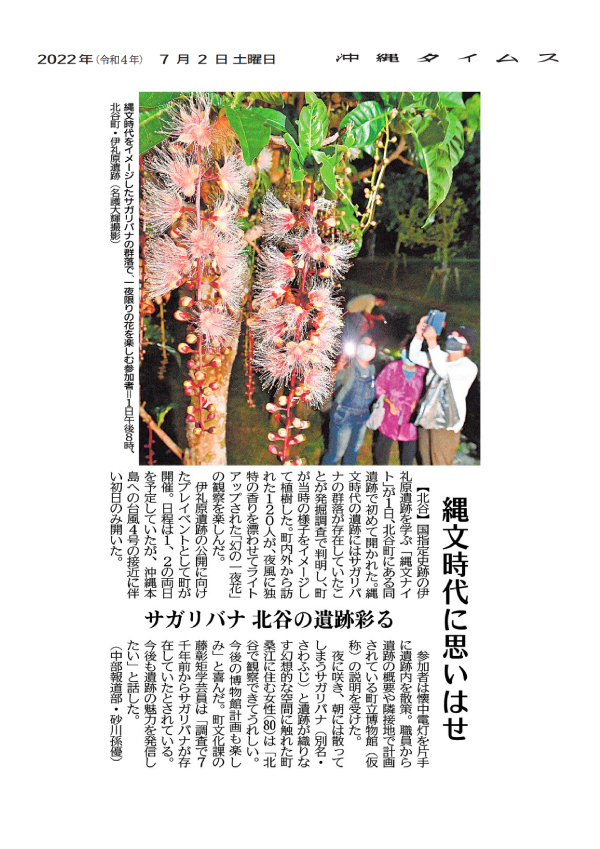
Participants enjoying the one-night-only flowers in a colony of Sagaribana that evokes the Jomon Period. Taken at July 1st at8 pm in the Ireibaru Ruins in Chatan Town (photo by Daiki Nago).
------------------------------
Thinking of the Jomon Period
Sagaribana, barringtonia racemose decorate the ruins in Chatan
On January 1st, the first “Jomon Night” was held at the Ireibaru Ruins in Chatan Town, Okinawa Prefecture to help people learn about the Ireibaru Ruins, a nationally designated historic site. Excavations revealed the existence of a colony of Sagaribana at the Jomon-era ruins, and the town planted trees to evoke the atmosphere of that long-ago time. 120 visitors from the town and elsewhere enjoyed observing the “phantom overnight flower” illuminated with its unique fragrance in the night breeze.
The event was held by the town as a pre-event for the opening of the Ireibaru ruins to the public, and was scheduled for the 1st and 2nd, but was only held on the first day due to the approach of Typhoon No.4 to the main island of Okinawa.
Participants strolled around the ruins with flashlights in their hands. The staff gave them an overview of the ruins and an explanation of the Town Museum (tentative name) which is planned for the adjacent land.
A Kuwae resident, an 80 year old woman, who was able to experience the fantastic space created by ruins and the Sagaribana (also known as Sawafuji), which blooms at night and sheds its petals in the morning, commented that, “I am happy to be able to observe it in Chatan. I’m looking forward to seeing the future plans for the museum as well.” Akinori Fuji, curator of the town’s Cultural Affairs Department, said, “Research has shown that the Sagaribana has existed for 7,000 years. We hope to continue to promote the charm of these ruins.” (Mr. Sunagawa, Chubu News Department)

Participants enjoying the one-night-only flowers in a colony of Sagaribana that evokes the Jomon Period. Taken at July 1st at8 pm in the Ireibaru Ruins in Chatan Town (photo by Daiki Nago).
------------------------------
Okinawa Times,Thursday, July 7, 2022
Gonzui, Euscaphis japonica, fruits
Bright red “Mihan chagi”
Futami, Nago City
On July 1st, bright red berries were observed on a Gonzui, Euscaphis japonica (Staphyleaceae) tree growing wild along Route 331 near the three-way junction in Futami, Nago City. The shrub is about three meters tall and bears many red berries of about 1cm in length on 15cm long conical inflorescence at the tips of its branches. The leaves are in opposing pairs, facing each other. They are about 8 cm long and 3 to 4cm wide, curled up to the back with jagged edges. The ripe berries split open to reveal spherical, black seeds about 5 mm in diameter.
The appearance of black seeds emerging from the bright red pulp resembles a “flipped over eyelid,” so it is called “mihan chagi” or “mipan chagi,” depending on the local dialect.
(Reported by Manabu Tamaki)
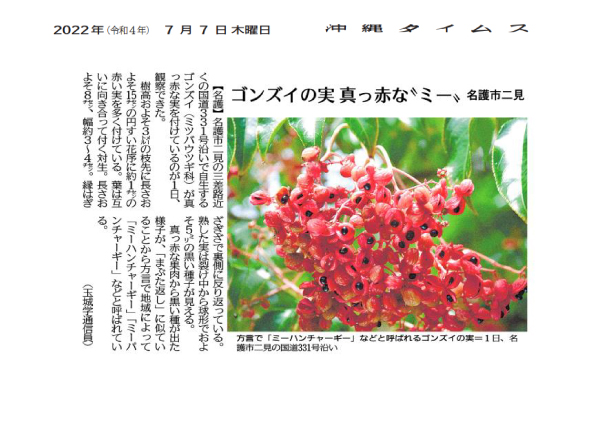
Gonzui fruits called “mihan chagi” in the local dialect along Route 331 in Futami, Nago City on July 1st.
------------------------------
Gonzui, Euscaphis japonica, fruits
Bright red “Mihan chagi”
Futami, Nago City
On July 1st, bright red berries were observed on a Gonzui, Euscaphis japonica (Staphyleaceae) tree growing wild along Route 331 near the three-way junction in Futami, Nago City. The shrub is about three meters tall and bears many red berries of about 1cm in length on 15cm long conical inflorescence at the tips of its branches. The leaves are in opposing pairs, facing each other. They are about 8 cm long and 3 to 4cm wide, curled up to the back with jagged edges. The ripe berries split open to reveal spherical, black seeds about 5 mm in diameter.
The appearance of black seeds emerging from the bright red pulp resembles a “flipped over eyelid,” so it is called “mihan chagi” or “mipan chagi,” depending on the local dialect.
(Reported by Manabu Tamaki)

Gonzui fruits called “mihan chagi” in the local dialect along Route 331 in Futami, Nago City on July 1st.
------------------------------
Okinawa Times, Wednesday, July 6, 2022
Vibrant vermilion blossoms of the Ogocho (Peacock Flowers)
Okinawa City
Vibrant vermilion flowers of the Ogocho, which means large butterflies, (Peacock flowers in English) are blooming along the waterway between the Shiomi Bridge and the Shin-Awase Bridge near Misato Technical High School in Awase Okinawa City. The long stamens and petals swaying in the wind look like dancing butterflies, thus the name. Along with Sandanka, Chinese ixora, and Deigo, Erythrina variegata it is considered to be one of the three major flowers in Okinawa.
According to the Okinawa Meteorological Observatory, on the 5th many places in the Okinawa region experienced a midsummer day with temperatures exceeding 30 ℃, with Kume Island recording 32.6 ℃ ,the highest temperature recorded this year. Naha was 31.4 ℃ . On the 6th, high pressure is expected to bring mostly clear skies, with a few showers and thunderstorms in some places.
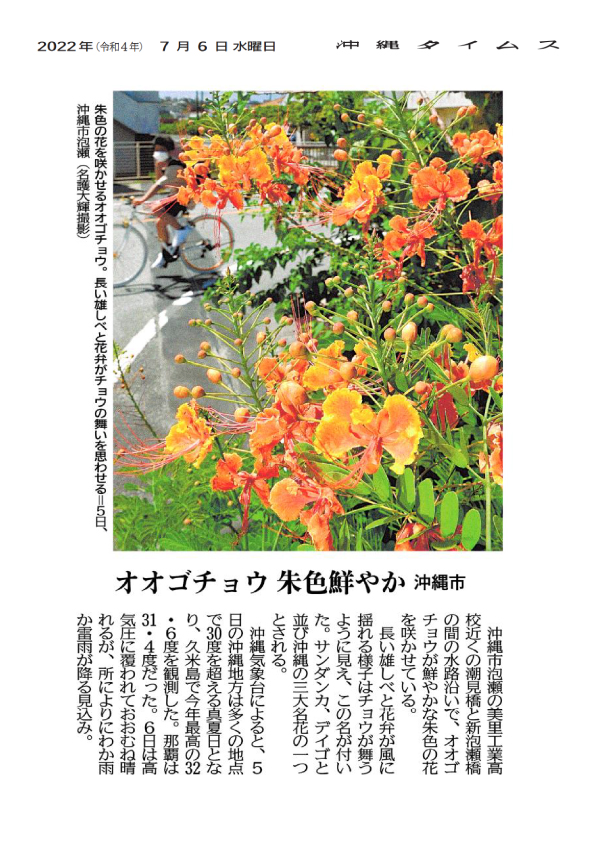
The vermilion flowers of the Ogocho, which means large butterflies, (Peacock flowers in English) are in full bloom. The long stamens and petals remind one of a fluttering butterfly. Taken in Awase, Okinawa City on July 5th. (Photo by Daiki Nago)
------------------------------
Vibrant vermilion blossoms of the Ogocho (Peacock Flowers)
Okinawa City
Vibrant vermilion flowers of the Ogocho, which means large butterflies, (Peacock flowers in English) are blooming along the waterway between the Shiomi Bridge and the Shin-Awase Bridge near Misato Technical High School in Awase Okinawa City. The long stamens and petals swaying in the wind look like dancing butterflies, thus the name. Along with Sandanka, Chinese ixora, and Deigo, Erythrina variegata it is considered to be one of the three major flowers in Okinawa.
According to the Okinawa Meteorological Observatory, on the 5th many places in the Okinawa region experienced a midsummer day with temperatures exceeding 30 ℃, with Kume Island recording 32.6 ℃ ,the highest temperature recorded this year. Naha was 31.4 ℃ . On the 6th, high pressure is expected to bring mostly clear skies, with a few showers and thunderstorms in some places.

The vermilion flowers of the Ogocho, which means large butterflies, (Peacock flowers in English) are in full bloom. The long stamens and petals remind one of a fluttering butterfly. Taken in Awase, Okinawa City on July 5th. (Photo by Daiki Nago)
------------------------------
Okinawa Times, Tuesday, July 12, 2022
Tokkuriran, Ponytail palm flowering in Ginoza
Yara Brothers Bonsai Garden
Tokkuriran, Ponytail palm, is in full bloom at the Yara Bonsai Garden, run by brothers Tsuneo Yara, 71, and Masaru Yara, 67, of Ginoza Village. The Tokkuriran is a tall evergreen tree native to Mexico. The lower part of the trunk swells up, making it look like a tokkuri, small sake bottles. It is said to bloom only once every few decades, so blooming is a rare occurrence. Tsuneo, who guided us around tree, was also surprised, saying, “I’ve been watching it for over thirty years, but this is the first time the flowers have bloomed.” Pale yellow flowers are blooming all at once at the top of the tree, which is over five meters tall. Tsuneo said, “We sell bonsai trees, so if you contact us, we will be happy to show you the Tokkuriran as well.”
(Reported by Fumiko Yamauchi)
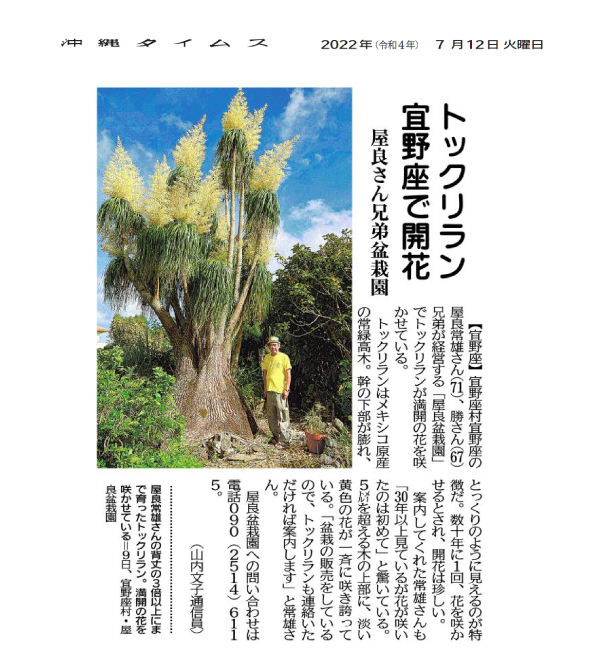
The Tokkuriran has grown to be more than three times the height of Tsuneo Yara. Flowers in full bloom at the Yara Bonsai Garden in Gonoza Village on March 9th.
------------------------------
Tokkuriran, Ponytail palm flowering in Ginoza
Yara Brothers Bonsai Garden
Tokkuriran, Ponytail palm, is in full bloom at the Yara Bonsai Garden, run by brothers Tsuneo Yara, 71, and Masaru Yara, 67, of Ginoza Village. The Tokkuriran is a tall evergreen tree native to Mexico. The lower part of the trunk swells up, making it look like a tokkuri, small sake bottles. It is said to bloom only once every few decades, so blooming is a rare occurrence. Tsuneo, who guided us around tree, was also surprised, saying, “I’ve been watching it for over thirty years, but this is the first time the flowers have bloomed.” Pale yellow flowers are blooming all at once at the top of the tree, which is over five meters tall. Tsuneo said, “We sell bonsai trees, so if you contact us, we will be happy to show you the Tokkuriran as well.”
(Reported by Fumiko Yamauchi)

The Tokkuriran has grown to be more than three times the height of Tsuneo Yara. Flowers in full bloom at the Yara Bonsai Garden in Gonoza Village on March 9th.
------------------------------
Okinawa Times, Sunday, July 3, 2022
Nineteen large Paramitsu, Jackfruits
Ishigaki Health and Welfare Center
Many giant tropical “Jackfruit” fruits have grown in the courtyard of the Health and Welfare Center in Tonoshiro, Ishigaki City, and visitors are surprised to see them, exclaiming, “Wow, so many, and so huge!”.
The tree is about seven meters tall with a trunk diameter of thirty centimeters.
Oblong fruits, each about 20 cm in diameter and 40-45 cm long, hang from the trunk, from several tens of centimeters to 2.5 meters above ground.
The surface of the fruits is covered with protuberances and are green or yellowish green, turning brown when ripe. It’s not known when the tree was planted, but the first fruiting was said to be two fruits in the fall of five years ago.
Since then, it has been fruitful mainly in early summer and fall, and the number of the fruits has increased. Atsushi Koike, the chief of the center, says, “It bears about twenty fruits at a time. The center staff will hardly consume any of them, so we will give them to those who wish to receive them.”
Paramitsu is an evergreen tree of the mulberry family. It is native to South India and its English name is Jackfruit. The fruit is a cluster of many small fruits like a fig. When ripe, it releases a pineapple-like aroma. It can be eaten raw, cooked, dried, and used in syrups.
(Reported by Shigeru Ota)
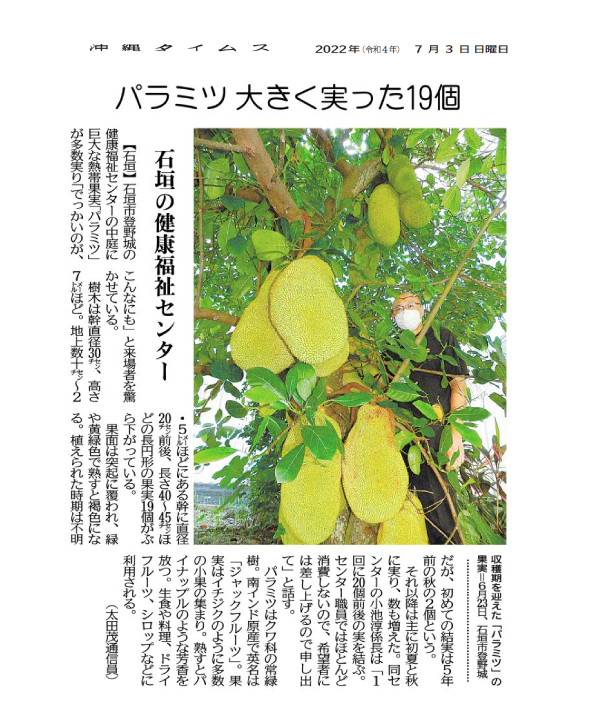
Harvest season of “Jackfruit” fruits in Tonoshiro, Ishigaki City on July 23rd.
------------------------------
Nineteen large Paramitsu, Jackfruits
Ishigaki Health and Welfare Center
Many giant tropical “Jackfruit” fruits have grown in the courtyard of the Health and Welfare Center in Tonoshiro, Ishigaki City, and visitors are surprised to see them, exclaiming, “Wow, so many, and so huge!”.
The tree is about seven meters tall with a trunk diameter of thirty centimeters.
Oblong fruits, each about 20 cm in diameter and 40-45 cm long, hang from the trunk, from several tens of centimeters to 2.5 meters above ground.
The surface of the fruits is covered with protuberances and are green or yellowish green, turning brown when ripe. It’s not known when the tree was planted, but the first fruiting was said to be two fruits in the fall of five years ago.
Since then, it has been fruitful mainly in early summer and fall, and the number of the fruits has increased. Atsushi Koike, the chief of the center, says, “It bears about twenty fruits at a time. The center staff will hardly consume any of them, so we will give them to those who wish to receive them.”
Paramitsu is an evergreen tree of the mulberry family. It is native to South India and its English name is Jackfruit. The fruit is a cluster of many small fruits like a fig. When ripe, it releases a pineapple-like aroma. It can be eaten raw, cooked, dried, and used in syrups.
(Reported by Shigeru Ota)

Harvest season of “Jackfruit” fruits in Tonoshiro, Ishigaki City on July 23rd.
------------------------------
Okinawa Times, Sunday, July 10, 2022
An Abundance of Pears
Making them into Pear Jam
Ms. Shimabukuro’s home in Uruma City
In the garden of Ms. Tomoko Shimabukuro, 80, in Gushikawa, Uruma City, pears are growing in profusion on the branches, beautiful against the slightly hot sky. The pear tree is about six meters tall, with a root circumference of 56 centimeters, and has about 80 pears on it. Her late husband, Tadao, bought the pear seedling at a plant fair in Okinawa City about forty years ago. According to her it has been bearing fruit for about ten years. “I didn’t know the best way to eat them until now,” she said with a smile, “but I would like to learn more from my friends and neighbors and make jam out of the pears.”
Her friend Emiko Tatsumi, 76, said, “We’re friends who do morning exercises together outside, following along with the daily radio exercise program, and then afterwards have coffee and gaze at the pears at Tomoko’s house. It would be fun to make jam,” she added, holding the pears in her hands. (Reported by Tokuzo Yokota)
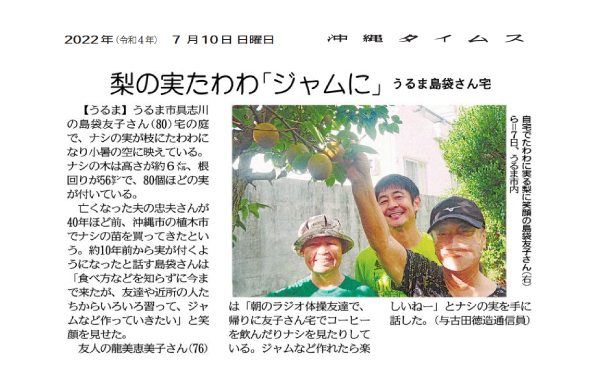
Tomoko Shimabukuro (right) and others smile at the abundant pears at her home in Uruma City on July 7th.
------------------------------
An Abundance of Pears
Making them into Pear Jam
Ms. Shimabukuro’s home in Uruma City
In the garden of Ms. Tomoko Shimabukuro, 80, in Gushikawa, Uruma City, pears are growing in profusion on the branches, beautiful against the slightly hot sky. The pear tree is about six meters tall, with a root circumference of 56 centimeters, and has about 80 pears on it. Her late husband, Tadao, bought the pear seedling at a plant fair in Okinawa City about forty years ago. According to her it has been bearing fruit for about ten years. “I didn’t know the best way to eat them until now,” she said with a smile, “but I would like to learn more from my friends and neighbors and make jam out of the pears.”
Her friend Emiko Tatsumi, 76, said, “We’re friends who do morning exercises together outside, following along with the daily radio exercise program, and then afterwards have coffee and gaze at the pears at Tomoko’s house. It would be fun to make jam,” she added, holding the pears in her hands. (Reported by Tokuzo Yokota)

Tomoko Shimabukuro (right) and others smile at the abundant pears at her home in Uruma City on July 7th.
------------------------------
Okinawa Times, Saturday, June 18, 2022
Spiky fruits
Abundant Paramitsu, Jackfruits
In the garden of a private home in Yoshihara, Chatan Town, Okinawa Prefecture a jackfruit tree a variety originally from East Asia, southern Taiwan and Yunnan Province, China, is bearing dozens of fruits. Friends who visit the house are astonished. “Wow! They’re amazing!” they say. “They look like spiky rugby balls.”
The homeowner, a woman in her 70s, said, “My late husband planted the tree about thirty years ago. It bore many thumb-sized fruits, but three years ago, it produced two large fruits for the first time.”
A friend brought some home to taste, but “Didn’t report back on how they tasted,” she said. “So maybe they didn’t taste good.” This year the tree produced many fruits and four of them dropped. However, since she wasn’t sure the best way to eat them, she left them alone.
The tree is about three meters tall and the branches are about two meters wide. The homeowner said that the fruit grows from the trunk, which is about 130 centimeters high from the base, and she added that the largest fruit must weigh more than three kilograms.
Mr. Kiyoshi Nakaji, Mr. Katsunari Takayasu, Mr. Hiroshi Miyazato, and others of the “Jikishinkai” group, who volunteer to cut grass at the elderly’s homes and parks in the community, said, “Wow, they are huge. The outer skin looks tough.”
Mr. Takayasu checked on his smartphone and reported finding that “When they’re yellow they’re ripe and ready to eat. They taste like bananas but without the sourness.”
(Reported by Yoshikatsu Onaga)
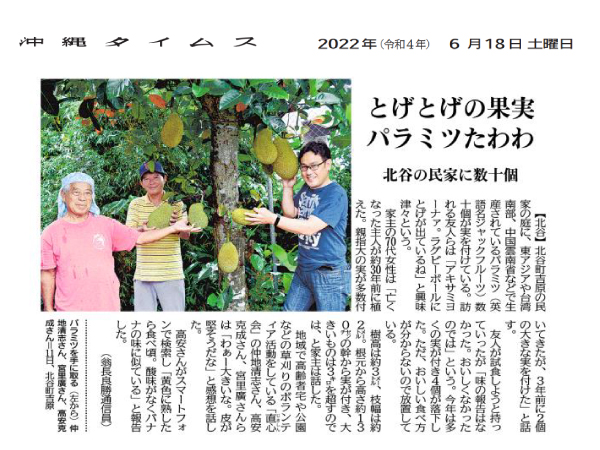
From the left, Mr. Kiyoshi Nakaji, holding a jackfruit, and Mr. Hiroshi Miyasato and Mr. Katsunari Takayasu, on June 11th, in Yoshihara, Chatan Town
------------------------------
Spiky fruits
Abundant Paramitsu, Jackfruits
In the garden of a private home in Yoshihara, Chatan Town, Okinawa Prefecture a jackfruit tree a variety originally from East Asia, southern Taiwan and Yunnan Province, China, is bearing dozens of fruits. Friends who visit the house are astonished. “Wow! They’re amazing!” they say. “They look like spiky rugby balls.”
The homeowner, a woman in her 70s, said, “My late husband planted the tree about thirty years ago. It bore many thumb-sized fruits, but three years ago, it produced two large fruits for the first time.”
A friend brought some home to taste, but “Didn’t report back on how they tasted,” she said. “So maybe they didn’t taste good.” This year the tree produced many fruits and four of them dropped. However, since she wasn’t sure the best way to eat them, she left them alone.
The tree is about three meters tall and the branches are about two meters wide. The homeowner said that the fruit grows from the trunk, which is about 130 centimeters high from the base, and she added that the largest fruit must weigh more than three kilograms.
Mr. Kiyoshi Nakaji, Mr. Katsunari Takayasu, Mr. Hiroshi Miyazato, and others of the “Jikishinkai” group, who volunteer to cut grass at the elderly’s homes and parks in the community, said, “Wow, they are huge. The outer skin looks tough.”
Mr. Takayasu checked on his smartphone and reported finding that “When they’re yellow they’re ripe and ready to eat. They taste like bananas but without the sourness.”
(Reported by Yoshikatsu Onaga)

From the left, Mr. Kiyoshi Nakaji, holding a jackfruit, and Mr. Hiroshi Miyasato and Mr. Katsunari Takayasu, on June 11th, in Yoshihara, Chatan Town
------------------------------
Okinawa Times, Sunday, June 19, 2022
Amur falcon
A Stray bird flies to Ishigaki
Mr. Masahiro Kobayashi (47) of “Sea Beans,” a field guide service in Ishigaki Island, took this photo. According to Mr. Kobayashi, he photographed a small bird of prey perched on an electric line, which turned out to be an Amur falcon. It flew away from the electric line, and when it returned, it had captured a Pacific swallow. Mr. Kobayashi said, “At first it was a puzzle to me because they never fly in at this time of year. I was surprised at the strange encounter, and wondered if it was an individual that had bred on the continent this season that had flown in.”
The Amur falcon is a member of the Falconidae family. It breeds in limited areas of China and the Korean Peninsula and overwinters in southern Africa and other regions.
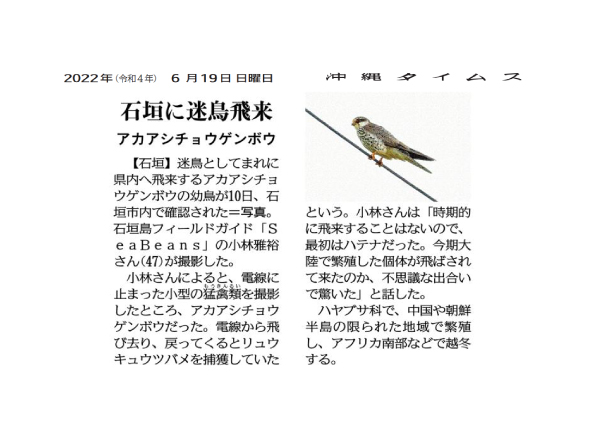
Photo: A young Amur falcon, which rarely strays into the prefecture, was confirmed in Ishigaki City on the 10th.
------------------------------
Amur falcon
A Stray bird flies to Ishigaki
Mr. Masahiro Kobayashi (47) of “Sea Beans,” a field guide service in Ishigaki Island, took this photo. According to Mr. Kobayashi, he photographed a small bird of prey perched on an electric line, which turned out to be an Amur falcon. It flew away from the electric line, and when it returned, it had captured a Pacific swallow. Mr. Kobayashi said, “At first it was a puzzle to me because they never fly in at this time of year. I was surprised at the strange encounter, and wondered if it was an individual that had bred on the continent this season that had flown in.”
The Amur falcon is a member of the Falconidae family. It breeds in limited areas of China and the Korean Peninsula and overwinters in southern Africa and other regions.

Photo: A young Amur falcon, which rarely strays into the prefecture, was confirmed in Ishigaki City on the 10th.
------------------------------
Okinawa Times, Wednesday, June 22, 2022
Sparrowhawk raises its young on a roadside tree
A sparrowhawk, the only hawk that breeds on the main island of Okinawa, has built a nest in a roadside tree in Kakazu, Itoman City, and is raising its young. On the 21st, four chicks were observed tentatively flapping their wings and begging their parents for food. It’s expected they will leave the nest in about a week. The original habitat of the Sparrowhawk is forests, but in recent years, an increasing number of them have been breeding in urban areas such as parks. Adult birds are about 30 cm in length, making them the smallest hawks living in Japan.
Kozo Hashimoto of the Southern Nature Preservation Society, who has been observing the birds since early June, said, happily, “They built a nest in the same Deigo tree two years in a row. Last year, there were two nests, and this year, four will leave the nest despite the heavy rains during the rainy season.”
(Hiroya Shimoji, Photography Department)
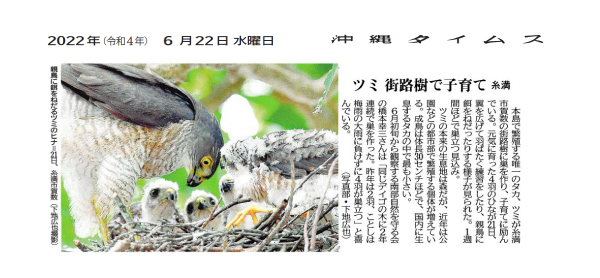
Photo: A sparrowhawk chick begging its parents for food on the 21st, in Kakazu, Itoman City (Photographed by Hiroya Shimoji)
Sparrowhawk raises its young on a roadside tree
A sparrowhawk, the only hawk that breeds on the main island of Okinawa, has built a nest in a roadside tree in Kakazu, Itoman City, and is raising its young. On the 21st, four chicks were observed tentatively flapping their wings and begging their parents for food. It’s expected they will leave the nest in about a week. The original habitat of the Sparrowhawk is forests, but in recent years, an increasing number of them have been breeding in urban areas such as parks. Adult birds are about 30 cm in length, making them the smallest hawks living in Japan.
Kozo Hashimoto of the Southern Nature Preservation Society, who has been observing the birds since early June, said, happily, “They built a nest in the same Deigo tree two years in a row. Last year, there were two nests, and this year, four will leave the nest despite the heavy rains during the rainy season.”
(Hiroya Shimoji, Photography Department)

Photo: A sparrowhawk chick begging its parents for food on the 21st, in Kakazu, Itoman City (Photographed by Hiroya Shimoji)
(July, 26. 2022)
Editor’s Picks
-

#196 The Steadily Evolving EM Nature Farming Method at the Blue Sky Palace - Part 6 -
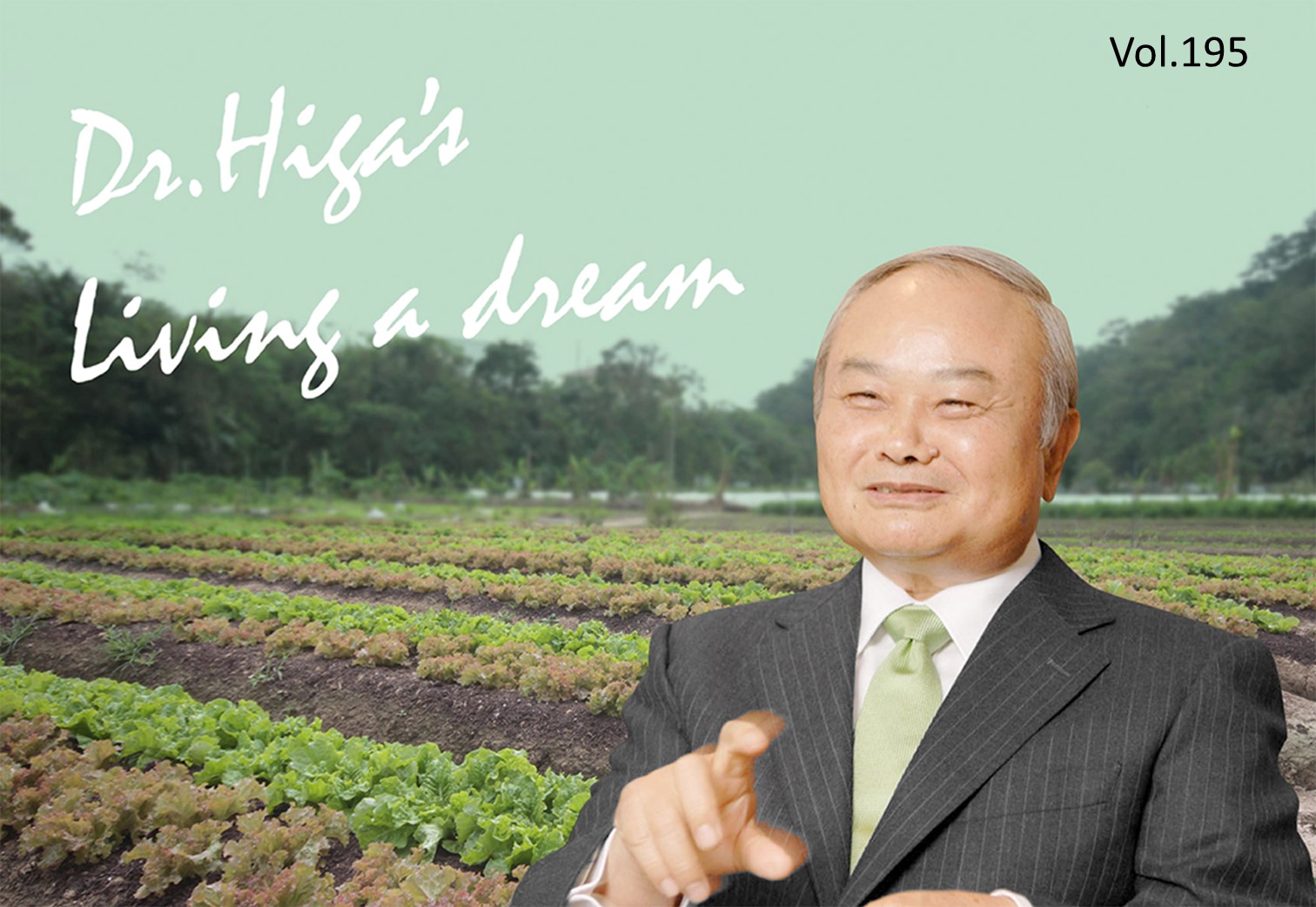
#195 The Steadily Evolving EM Nature Farming Method at the Blue Sky Palace - Part 5 -

#191 Steadily Evolving EM Nature Farming Method at the Blue Sky Palace -
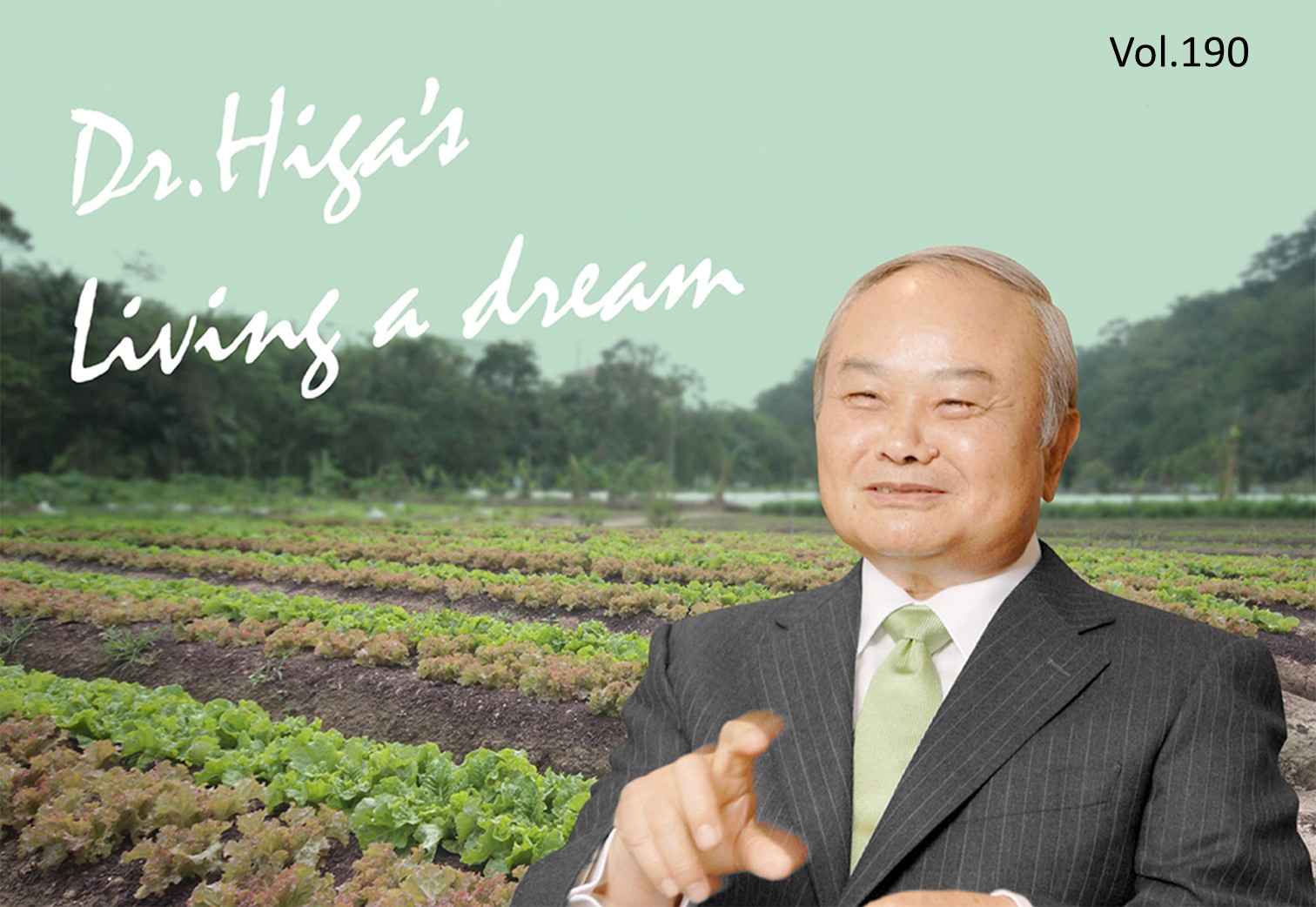
#190 Quantum Mechanical Effects of EM Gravitron Charcoal
- 2025
- Sep:#209 The Widespread Use of EM in Ecuador
- Sep:#208 The Widespread Use of EM in Chile
- Jul:#207 Peru, where EM has taken root throughout the country
- May:#206 EM Application Technology in Paraguay Begins to Evolve into Advanced Circular Agriculture
- May:#205 Practical Application of Soil Disinfectant-Free Cultivation Using EM Technology
- Apr:#204 How EM Use Has Spread Throughout the Philippines
- Mar:#203 How to Use EM to Fundamentally Solve the Problem of Agricultural Residue Burning
- Feb:#202 The Spread of EM technology in Germany
- Jan:#201 The 2nd Ichiro Masaki Memorial Universal Village EM International Conference
- Jan:#200 Cleanup of the Ala Wai Canal in Hawaii, where social bonds are strengthened using EM
- 2024
- Nov:#199 EM trials in India with bananas, tomatoes, and pomegranates
- Oct:#198 The Steadily Evolving EM Nature Farming Method at the Blue Sky Palace - Part 8
- Sep:#197 The Steadily Evolving EM Nature Farming Method at the Blue Sky Palace - Part 7
- Aug:#196 The Steadily Evolving EM Nature Farming Method at the Blue Sky Palace - Part 6
- Jul:#195 The Steadily Evolving EM Nature Farming Method at the Blue Sky Palace - Part 5
- Jun:#194 Steadily Evolving EM Nature Farming Method at the Blue Sky Palace - Part 4
- May:#193 Steadily Evolving EM Nature Farming Method at the Blue Sky Palace - Part 3
- May:#192 Steadily Evolving EM Nature Farming Method at the Blue Sky Palace - Part 2
- Apr:#191 Steadily Evolving EM Nature Farming Method at the Blue Sky Palace
- Mar:#190 Quantum Mechanical Effects of EM Gravitron Charcoal
- Mar:#189 The barrier space in Okinawa (Ryukyu Islands) has risen to another dimension
- Jan:#188 Sixty Days after Typhoon No.6
- 2023
- Oct:#187 Supermassive Typhoon No.6 and Subsequent Typhoon No. 11
- Sep:#186 Massive Typhoon No.6 that swallowed the Ryukyu Islands Graviton barrier
- Sep:#185 August 8th is World “EM Mudball Day”
- Aug:#184 A disease-free life depends on the health of the intestinal microbiome.
- Jul:#183 Trial and Error at the Blue-Sky Palace, Part 3
- Jun:#182 Trial and Error at the Blue-Sky Palace, Part 2
- Apr:#181 Trial and Error at the Blue-Sky Palace
- Mar:#180 Ala Wai Canal Cleanup Project in Waikiki, Hawaii
- Feb:#179 High-Yield, High-Quality Rice Production Using EM
- Feb:#178 The Progress the "Soil Preparation Workshop" of the Oishi 3-chan Club (Part 2)
- Jan:#177 Organic Farming Instructional Manual Using EM
- 2022
- Nov:#176 The Typhoon Situation in Okinawa in 2022
- Sep:#175 Third-Party Verification of the Graviton barrier in Okinawa Part-2
- Sep:#174 Third-Party Verification of the Graviton barrier in Okinawa
- Aug:#173 Ecosystem Changes Observed in Okinawa in 2021 Part-5
- Jun:#172 Ecosystem Changes Observed in Okinawa in 2021 Part-4
- May:#171 Ecosystem Changes Observed in Okinawa in 2021 Part-3
- Apr:#170 Ecosystem Changes Observed in Okinawa in 2021 Part-2
- Mar:#169 Koizumi Farm in Kamakura Continues to Evolve
- Feb:#168 Ecosystem Changes Observed in Okinawa in 2021 Part-1
- 2021
- Dec:#167 Enjoying EM Technology While Enriching the Local Ecosystem
- Nov:#166 A Case Study of the Use of EM in a Next Generation Free School in Tune with the Cycles of Nature
- Oct:#165 Typhoon conditions and flowers in Okinawa from August to October
- Sep:#164 Re-learning the origins of river purification using EM Cleaning up the Dairyuji River in Senami (Murakami City, Niigata Prefecture)
- Aug:#163 Measures Against Natural Disasters and Re-learning the Starting Point of EM
- Jul:#162 Summary of FFC (Foods for Children) Okinawa Forum 2021
- Jun:#161 Restoring the Vigor of an Old Tree and Purifying the Environment with EM Technology That Even an Amateur Can Do
- May:#160 The Public is Beginning to Recognize the Use of EM Smokeless Carbonizers
- Apr:#159 EM Hado (EM Graviton) that exerts quantum superposition effect over time
- Mar:#158 Virus-free Okinawan Plants Through Use of an EM Graviton Barrier
- Jan:#157 Enjoyable Farming for Self-Sufficiency that Even Amateurs Can Do
- 2020
- Dec:#156 EM quantum energy effect occurring in Okinawa
- Nov:#155 Implementing EM graviton farming as a flood countermeasure for apple orchards
- Oct:#154 The Latest Book on the Practical Uses of EM "You Are the One Who Draws Out the Power of Microorganisms," by Chizuko Nomoto
- Sep:#153 Application of EM technology to long periods of rain, lack of sunshine, storms, heavy rains, etc.
- Aug:#152 EM application in Kitanakagusuku village plant waste recycling yard
- Jul:#151 Natural Disaster Countermeasures Using EM Technology: Part 2
- Jul:#150 Natural Disaster Countermeasures Using EM Technology
- May:#149 How to make your home and workplace an energy spot by living a complete EM lifestyle: creating the ultimate source of health and environmental purification
- Apr:#148 EM, Viruses and the Pandemic
- Apr:#147 New agriculture applying quantum mechanics Part 2
- Apr:#146 New agriculture applying quantum mechanics
- Apr:#145 Wonderful EM Miracle
- 2019
- Nov:#144 The movie “Revival II” and the reality of Fukushima
- Oct:#143 Boundary dome and foliar spraying of EM・X GOLD and EM 3
- Oct:#142 Kirakira (Sparkling) Summer Vegetable Festa in 2019
- Aug:#141 Excessive salt inevitably causes salt damage
- Jul:#140 Diverse applications of charcoal Part 3
- Jun:#139 Diverse applications of charcoal Part 2
- Jun:#138 Diverse applications of charcoal
- Jun:#137 Purification power of salt
- May:#136 The degree of soil contamination is a reflection of the microflora
- May:#135 Definitive use of EM barriers to deal with typhoons
- May:#134 Implementing authentic Nature Farming
- May:#133 How to enhance healthy Hado (wave energy) by EM
- May:#132 Eating Dirt (Soil)
- May:#131 Hado (Wave energy) involved in health
- May:#130 Reaffirming EM technology to realize the essence of agriculture
- May:#129 The 2nd EM Producer Networking Meeting
- Apr:#128 Understanding the application of seawater and salt in crop cultivation
- Apr:#127 Prevention of Disasters by EM Technology
- Mar:#126 Quantum overlay effective utilization of EM
- Jan:#125 EM Disaster Recovery Support Projects in 2017
- 2018
- 2017
- Aug:#121 Escape from conventional agricultural traps
- Jul:#120 Limitation and important caveats regarding utilization of salt
- Jun:#119 EM Technology to Break Through the Limits of Pesticide-Free Strawberries
- May:#118 Application of barriers using EM rectification force
- Apr:#117 The 1st EM Produce Growers' Networking Conference
- Mar:#116 Sumizo kun: The Ultimate Versatile Carbonization Equipment
- Feb:#115 How to make and use simple carbonized and rectified ash
- Jan:#114 Achievements of 2016
- 2016
- Dec:#113 Definitive Measures Against Typhoons
- Nov:#112 International Conference on Universal Village
- Oct:#111 90% of Your Body is Microbes
- Sep:#110 Disaster Countermeasures Using EM
- Aug:#109: Changes in the Natural Environment by EM Barrier Domes in Okinawa
- Jul:#108: Multi-purpose Utilization of Activated EM with Seawater and Salt
- Jun:#107: Marine Day, when EM Mudballs and Activated EM are Applied Throughout Japan
- May:#106: The Function of EM and Gravitational Waves–Part 3
- Apr:#105: The Function of EM and Gravitational Waves–Part 2
- Feb:#104: The Function of EM and Gravitational Waves
- Feb:#103: The Importance of Phototrophic Bacteria in EM
- 2015
- Dec:#102: Results of Environmental Forum "Utsukushima EM Paradise" 2015
- Nov:#101: Environmental Forum "Utsukushima EM Paradise" 2015
- Oct:#100: A New Phase of Limit Breakthrough Using EM
- Sep:#99: A New Phase of Limit Breakthrough through EM
- Aug:#98: The Tokyo Bay Area Began Creating a Truly Livable Hometown
- Jul:#97: Rectifying Effects of EM
- Jun:#96: Lake Suwa Sousei lecture
- May:#95: In Order to Further Ensure Limit Breakthrough
- Apr:#94: Theatrical Release of the Documentary Film SOSEI-Revival to Enlighten People on the New Possibilities of Microorganisms
- Mar:#93: What Underlies Limit Breakthrough (Part 2)
- Feb:#92: EM Functions to Break Through Limits
- Jan:#91: At the Start of 2015
- 2014
- Dec:#90: Looking Back at 2014
- Nov:#89: Shikoku EM FESTA 2014, Virtuous Circle Conference in Matsuyama, Ehime Prefecture
- Oct:#88: Using EM to Deal with Weather Disasters (Part 2)
- Sep:#87: Current Status of Radioactivity Measures Using EM in Fukushima
- Aug:#86: APNAN (Asia Pacific Natural Agriculture Network) 25th Anniversary Conference in 2014
- Jul:#85: Using EM to Deal with Weather Disasters
- Jun:#84: Substantial Improvement of Soil
- May:#83: The Energy Rectification Force of EM
- Apr:#82: The Annual 18th EM Technology Exchange Meeting and Tohoku Conference in Shichigahama
- Mar:#81: Salmon going upstream in Kitaura (Kasumigaura)
- Feb:#80: The Microbiome Again
- Jan:#79: Inauguration of the Federation of Diet Members Who Use and Apply Effective Microorganisms
- 2013
- Dec:#78: Receiving an Honorary Doctoral Degree from Rajamangala University of Technology in Thailand
- Nov:#77: The Use of EM in School Education in Bhutan
- Oct:#76: Well of Bonding
- Sep:#75: The Background to EM Not Being Employed by Public Institutions to Deal with Radiation
- Aug:#74: Dealing with Disaster: Using EM in Crisis Management
- Jul:#73: EM Events on Ocean Day
- Jun:#72: Using EM to Deal With Heat Stroke and Summer Heat Fatigue
- May:#71: An EM Model Town in Malaysia
- Apr:#70: Steps the Japanese Government is Taking to Deal with Radiation: Are They Really Safe?
- Mar:#69: EM Group Disaster Reconstruction Aid Project in Fukushima
- Feb:#68: EM and Microbiomes (Microbial Flora)
- Jan:#67: A Necessary Evil is Still Evil
- 2012
- Dec:#66: The 17th National EM Technology Exchange Conference / Hokkaido Conference in Sapporo
- Nov:#65: EM Forum 2012 in Okinawa and the Environmental Forum in Fukushima
- Oct:#64: 2012 EM Forum
- Sep:#63: A New Earth Saving Revolution
- Aug:#62: The Asahi Newspaper’s Misguided Reports About EM
- Jul:#61: Using EM in Radioactive Contamination Measures in Fukushima Prefecture
- Jun:#60: The Effects of Using EM to Inhibit the Absorption of Radioactivity as Confirmed in Fukushima
- May:#59: Recovery Support for the Great East Japan Earthquake
- Apr:#58: The Royal Kingdom of Thailand, in which EM Functions as a Set Government Policy
- Mar:#57: Report on the Measures Taken by Kingdom of Thailand Using EM to Deal with Polluted Water
- Feb:#56 EM™ as Part of National Policy in Thailand to Deal with Sanitation Issues Resulting from the Flood of 2011
- Jan:#55 The Law of Syntropy (Revitalization)
- 2011
- Dec:#54 EM Forum 2011
- Nov:#53 Shikoku EM Festa 2011- Zenjunkan no Wa (Virtuous Circle) Tokushima Conference in Naruto -
- Oct:#52 The Mystery of Interim Safety Values for Radioactive Material
- Sep:#51 Successful Radiation Countermeasures Using EM
- Aug:#50 Events on Sea Day in which EM Mud Balls are Thrown into the Water and Activated EM is Applied.
- May:#47 Dealing with the Damage Caused by the Eastern Japan Earthquake
- Apr:#46 Eastern Japan Earthquake
- Mar:#45 The 16th National EM Technology Hokuriku Conference in Fukui
- Feb:#44 More Thoughts on Avian Influenza and Foot-and-Mouth Disease
- Jan:#43 Happy New Year!
- 2010
- Dec:#42 Shikoku EM FESTA 2010・Zenjunkan no wa (Virtuous Circle) Fellowship Conference in Tobe, Ehime Prefecture
- Nov:#41 EM Forum 2010
- Oct:#40: My Thanks to the EM™ Volunteers Who Helped in the Fight Against Foot-and-Mouth Disease in Miyazaki Prefecture
- Sep:#39 International EM Mud Ball Day
- Jul:#37 Poland EM Forum 2010
- Jun:#36 EM Countermeasures Against Foot-and-Mouth Disease
- May:#35 Abnormal Weather
- Apr:#34 EM Activities in Thailand: Finding Solutions to the Challenges Facing the Nation
- Mar:#33 New Developments in the Evolution of EMTM in Thailand
- Feb:#32 Results Starting to Be Seen at the Mikasa Project
- Jan:#31 Towards an EM-Use Society
- 2009
- Dec:#30 EM Summit
- Nov:#29 The System in Penang State in Malaysia that Made the World EMTM Mudball Day a Success
- Oct:#28 The "World EM Mudball Day" in Malaysia
- Sep:#27 Validating EMTM Medicine: Case Study Reports from EM Users 2009. (Part 3)
- Sep:#26 Validating EMTM Medicine: Case Study Reports from EMTM Users 2009. (Part 2)
- Jul:#25 Validating EMTM Medicine: Case Study Reports from EMTM Users 2009. (Part 1)
- Jun:#24 Activities to Disseminate EM-Focused Nature Farming in China
- May:#23 Use of EMTM in Response to Swine Flu
- Apr:#22 Using EM to Solve Public Administrative Costs
- Mar:#21 Reaffirming the Versatility of EM
- Jan:#20 The Beginning of a New Era
- 2008
